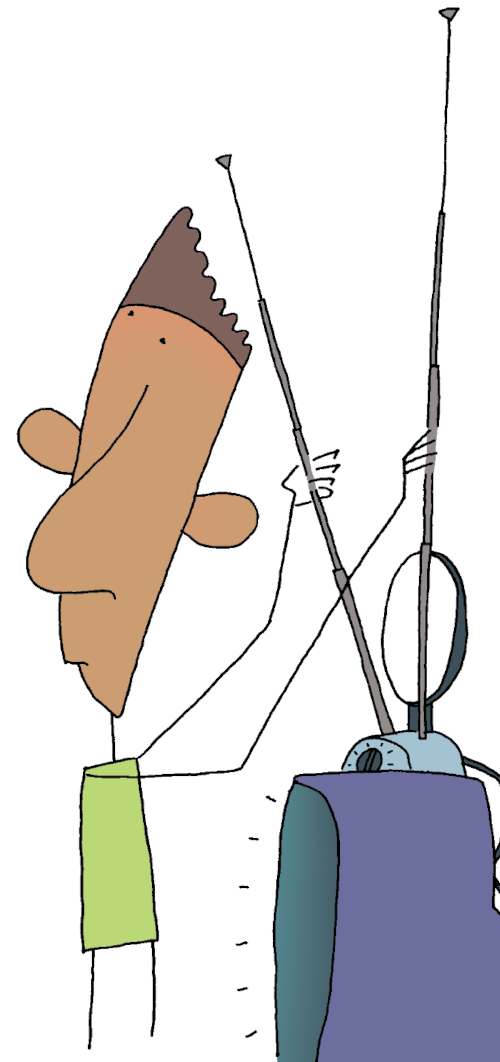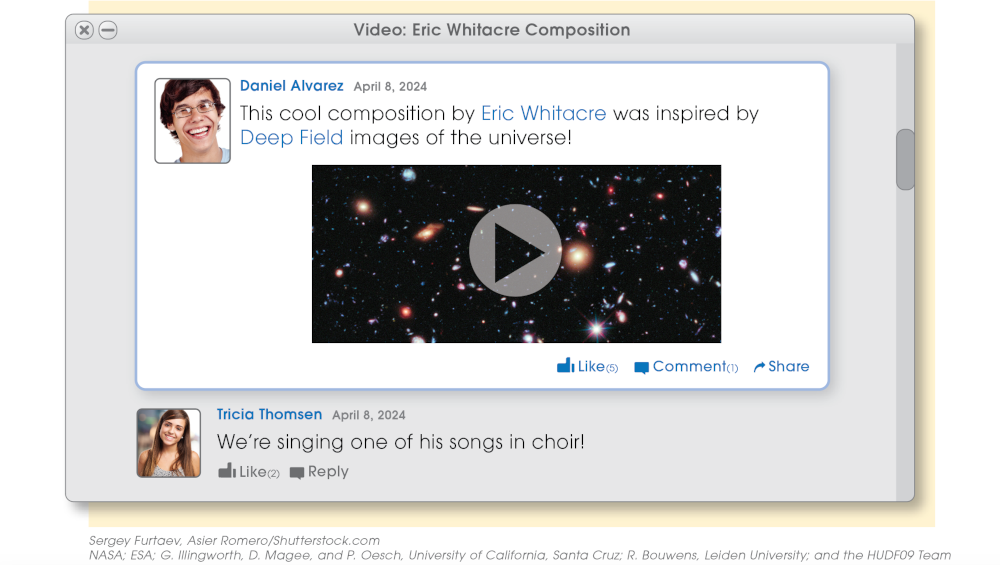WOC 427
Page 427

Viewing Skills
In the old days, viewing was pretty passive. People just sat on their couches and stared at their TVs. The only time they interacted was to adjust the “rabbit ears” for better reception.
Now, viewing is often quite active. Internet articles provide many links and interactives to choose from. Reality shows ask audiences to vote on their phones. And video games require intense attention and quick reactions.
Bring that same focus and engagement to all your viewing. Think carefully about websites, videos, documentaries, news shows, and commercials. Don’t just accept what they say.
Yes, view, but also think!
What’s Ahead
WOC 428
Page 428
Viewing Web Sites
The Internet is a popular source of information, but not all of it is accurate, fair, and reliable. When you look for information online, test it by answering these questions. (Download a checklist for viewing web sites.)
Who publishes or develops this site? ■ The publisher may be a company, a school, a person, a club, or some other group. Once you know who publishes the site, consider these additional questions:
- Is the information from a reliable source? Imagine that you’re looking for information about tornadoes. A Web site published by the National Weather Service has information from experts you can trust. A Web site published by someone who chases tornadoes as a hobby may not be as trustworthy.
- Is the information balanced or biased? Let’s say you’re looking for information about good eating habits. An Internet site published by a respected health magazine will most likely have balanced information. A Web site published by a company that produces breakfast cereal may be biased, making its products sound more healthful than they really are.
Who pays for it? ■ Whoever pays for a site gets to decide what is posted there. Remember that a site that contains advertising is paid for in part by the advertisers.
How often is the site updated? ■ Many Internet sites are updated every day or every week. But some sites may have information that is weeks, months, or even years out of date.
How does the information compare to other sources? ■ When you search for information on the Internet, look at more than one site, or compare it to the information in a book or magazine. This comparison will help you check for accuracy.
What other signs might show that this site is unreliable? ■ Here are some other red flags to be aware of:
- The site is anonymous. No authors are listed.
- The text is poorly written or looks unprofessional.
- The site is dominated by advertisements or pop-ups.
WOC 429
Page 429
Evaluating Online Videos
When you find a video you are interested in, click on it to watch it. Afterward, if you are a member of the video-sharing site, you can rate the video and leave comments.
- Rating videos: Rating the video (often by giving it from one to five stars) helps other viewers decide if they want to watch it.
- Leaving comments: Responding to the video or to another person’s comments gives you the opportunity to “talk with” other viewers and share ideas.
Sharing Videos
After you view a video, the site may suggest similar videos. Consider the picture, heading, ratings, and other information before deciding to watch other videos.
If you find a video you really like, the site often allows you to mark it in a number of ways:
- Favorites: Keep a list of favorite videos to easily find them again.
- Playlists: Keep a list of videos you enjoy viewing together, one after another.
- Share: Post videos to your page on a social networking site and share them with friends.

WOC 430
Page 430
Watching the News
Whether on TV or on a video-sharing site, you can tune in to the news to find out what is happening in your city or beyond. In either case, you need to watch and listen carefully and then judge whether a news story is complete, correct, and balanced.
Watch for Completeness
A good news story is complete. It answers the 5 W's (who? what? where? when? and why?). Here is the beginning of a news story. Notice how all 5 W’s are answered in the first sentences.

When viewing a news story, always listen carefully for its context. The story above went on to describe how the image shows a section of sky equal to a grain of sand held out at arm’s length. The “empty” spot turned out to be swarming with thousands of galaxies. This new image is an update and improvement on the original Hubble Deep Field image from 1995. Understanding the context helps you appreciate the importance of the story.

WoC 431
Page 431
Watch for Correctness
A good news story must be correct. The story should use only reliable witnesses or experts and never speculate. If reporters are unsure of all the facts, they must carefully word their stories to indicate this. Compare the following two news items, for example. The first gives information that was available just after the event. The second gives information that only became available later in the day.
First report ■ A high-speed train derailed in Germany today, and early reports are that as many as 30 people may have been killed.
Second report ■ The death toll now stands at 100 in the derailment of a German train. Rescuers continue to search the wreckage.
Helpful Hint
Early reports about a news event often are not complete or correct. Keep checking until all the facts are in.
Watch for Balance
No two people ever tell the same story exactly the same way. This is also true of news reporters. When you watch a TV news story, you are getting the news team’s point of view. They have made decisions that shape what you see and hear. Here are two ways that this is done:
- News teams decide which facts to tell and which pictures to show. A story about a high-crime area may show houses with broken windows and littered yards, but may neglect to show any of the well-kept homes in the same neighborhood.
- News teams decide which people to interview. Telling both sides of a story is important, but the individuals chosen to speak for each side will affect your opinion. For example, interviewing a popular police chief who supports a new law, and a gang leader who is against it, would not be a fair and balanced interview.
Helpful Hint
Notice the facts, images, and people included in a news story. Think about what may have been left out. Consider how these choices may affect your opinion of a situation.
WOC 432
Page 432
Watching Documentaries
Documentaries are programs that tell about one subject in depth. Their main purpose is to inform, although many are entertaining as well. If you are an active, thoughtful viewer, you can learn a lot from a good documentary. Here are some tips:
Before you watch . . .
- Find out what the program is about.
- Make a list of your questions after thinking about what you already know about the subject and what you’d like to learn. Leave room between questions for notes.
- Make sure you understand any questions your teacher may have given you to answer.
While you watch . . .
- Take a few brief notes. Spend most of your time watching; just write down key words that will help you compose complete answers later.
- Watch for completeness, correctness, and point of view.
- Jot down any additional questions you think of.
After you watch . . .
- Write complete answers to your questions while the program is fresh in your mind.
- Talk with someone else who watched the program. Individuals notice and remember different things. Ask each other, “What did you find most interesting? What was the name of that red bird? Did you understand the part about . . . ?” and so on.
- Write or talk about your feelings about the program. Did anything make you laugh, upset you, or confuse you? Exploring your feelings will help you remember more about the subject.
- Write a summary to help you remember the main points and ideas in the program. (See the next page.)
WOC 433
Page 433
Summary of a Documentary
What follows is a summary based on one student’s understanding of a documentary about ancient cities in the Amazon. It was written after the student talked about the program and reviewed his notes
Lost Cities of the Amazon
Main Idea The Amazon holds many surprises. This incredibly diverse rainforest is home to thousands of species of plants and animals. Only recently, though, have we realized it was also home to large cities of people.
Important Details Using lidar (light-based remote sensing technology), scientists have been able to see past the dense canopy to the ground. In a helicopter 650 feet above the trees, scientists shot millions of light beams down into the rainforest. Beams that struck ground bounced back, providing data points. Computers sorted the data to show features on the ground.
Among the discoveries is the city of Cotoca, a vast urban area in the Bolivian Amazon. It included pyramids, monumental platforms, and rings of moats and ramparts for defense. A network of raised causeways connected to many outlying suburbs. The site included canals as well as reservoirs. These features suggest that the area at the time was not rainforest but savannah. The Casarabe people, who lived there from 500–1400 B.C., abandoned the site 600 years ago, perhaps due to drought.
Interesting Final Fact These recent discoveries add to growing evidence of many Amazon settlements. So far, only Cotoca and another city called Landívar show true urban centers, but many other areas reveal extensive human activity. The Amazon as a vast forest untouched by humans is only a recent phenomenon. More studies seek to further explore the human history of this wild place.
WOC 434
Page 434
Watching Commercials
News programs and documentaries have the same main purpose: to inform you. But commercials have a completely different purpose: to persuade you. People who create commercials have several tried-and-true techniques for making people want to buy products. Here are a few of their favorite selling methods.
■ Slice of Life
A slice-of-life commercial looks like it was filmed on someone’s phone. It seems to show a bunch of real people having a great time drinking Brand X cola or wearing Brand X athletic shoes. These commercials can be convincing, but the people in them are actors. Each scene is carefully staged and rehearsed. It’s very possible that the actors holding cans of Brand X cola have never even tasted it!
■ Famous Faces
A famous-face commercial shows a celebrity using Brand X. This selling method is effective because many people want to be like their favorite celebrities. The idea is to make people think that if they buy Brand X cola, they will be more like the beautiful movie star or the superstar athlete who is in the commercial.
■ Problem-Solution
A problem-solution commercial shows someone with a problem, and then shows the product solving the problem. For example, a new kid moves to town. His problem is that he doesn’t know anybody or have any friends. Then he has an idea: He buys a few cans of Brand X cola and offers them to the guys playing basketball in the park. The guys love Brand X cola, so they decide the new guy is cool. Brand X solved his problem.
Helpful Hint
No matter which type of commercial you are viewing, consider the appropriateness of the visuals being used. Note the dress and actions of the actors, the special effects, and the color and lighting enhancements. Making these considerations will help you evaluate the reliability of the information in the ad.